The 18th century saw the birth of the philosophy of utilitarianism – the view that an action is just so long as it leads to greater happiness and unjust if it increases greater pain. The idea was expounded by English philosopher and social theorist Jeremy Bentham under “the principle of utility” theory in 1769.
The principles of utility guided Jeremy’s views on legal rights and government enforcement. Later, he used utilitarianism as the guiding principle to design the Panopticon – A prison system designed to maximize surveillance with the fewest possible guards. The design described a single watch tower surrounded by a circular prison with jail cells facing the watch tower. The tower would allow a guard to survey all the jail cells at once, while its windows were so small that prisoners couldn’t tell if the eyes were on them at any time.

The idea behind the design was to leverage the sociology of constant surveillance. The inmates couldn’t tell if they were being watched, so they always had to assume the presence of authority. The perceived omniscience of authority would deter prisoners from immoral behaviour, promoting greater harmony, peace, and compliance.
Today, the Panopticon serves as a metaphor for the sociological construct of the 21st-century digital age. Michel Foucault, a 20th-century philosopher, expanded on Bentham’s ideas. In his book “Discipline and Punish,” he perceived the panopticon as a symbol of modernized surveillance, where compliance is internalized with subtle systems rather than physically enforced. For instance, CCTV surveillance used around the globe to watch over physical space is intrinsically panoptic.
COVID-19 recontextualized Foucault’s insight into the panopticon. The need for a standard to record vaccinated and quarantined individuals and the increased demand for cashless money transfers ramped up the government’s identity digitization efforts around the globe.
“The COVID-19 pandemic has highlighted how digital connectivity is fast becoming the global metric of inclusion and exclusion with 2.9 billion people still offline.” - Achim Steiner, Administrator, United Nations Development Programme (UNDP)
Globalist institutions like the United Nations (UN) and the World Economic Forum (WEF) have been vocal advocates of Digital IDs as essential to accelerating developing countries' social, financial, and economic inclusion. However, the same tool has the potential to exert indomitable surveillance and control over its holders, as Guy covers in his video regarding concerns about unelected authoritarian bodies such as the WEF:
This report will explore the panoptic undertones of this duality of Digital ID’s capabilities.
What is an Identity?
The UN defines a legal identity as the basic characteristics of an individual’s identity, like name, sex, date, and place of birth granted through registration to an authorized civil registration authority and the issuance of a certificate following the occurrence of birth. The ethos of identity is to prove an individual’s uniqueness through accountable sources and to provide a means for legal, social, and economic interactions. Physical IDs are foundational or functional based on the purpose of identification.
- Like our passports, a foundational ID is a general-purpose ID meant to classify the population. These IDs are the means to render public and private sector transactions, like government schemes and services.
- A functional ID classifies a subset of a general population. It serves a specific purpose. Driving licenses, voter IDs, and health cards are all functional IDs.
What are Digital IDs
Where a physical ID is a tangible article we must keep in possession, a Digital ID is stored electronically (on private or cloud-based storage devices) and can be accessed remotely. It is the digital version of our physical IDs and may be issued by governing bodies, public or private entities, or individual entities.
In 2019, the McKinsey Global Institute delved into the impact of digital identification systems on the global economy and individual lives in a study on Digital IDs. The study came at a time when the international discourse was evolving around harnessing technology for inclusive growth to aid economies suffering from the rampant spread of COVID-19. Here are some noteworthy insights from McKinsey’s research.
McKinsey's Take on Digital Identification
The report lays down four attributes of a “good” digital ID:
- Verified and authenticated to a high degree of assurance: The digital ID must adhere to appropriate standards to be acceptable at public and private sector institutions for registration and subsequent redemption of benefits and services. The ID may use a range of credentials to achieve this assurance, including biometrics, QR codes, passwords, and identity-embedded smart devices.
- Unique: The digital ID must identify only one unique individual in the system, and each individual must correspond to one unique identification.
- Established with individual consent: The digital IDs must be registered with the consent of the corresponding individuals, who must be aware of the scope at which the identification may be used.
- Protects user privacy and ensures control over personal data: The digital ID management system must provide safeguards to ensure privacy and secure an individual’s data from unauthorized access. The ID holders must have control over who has access to their identification data.
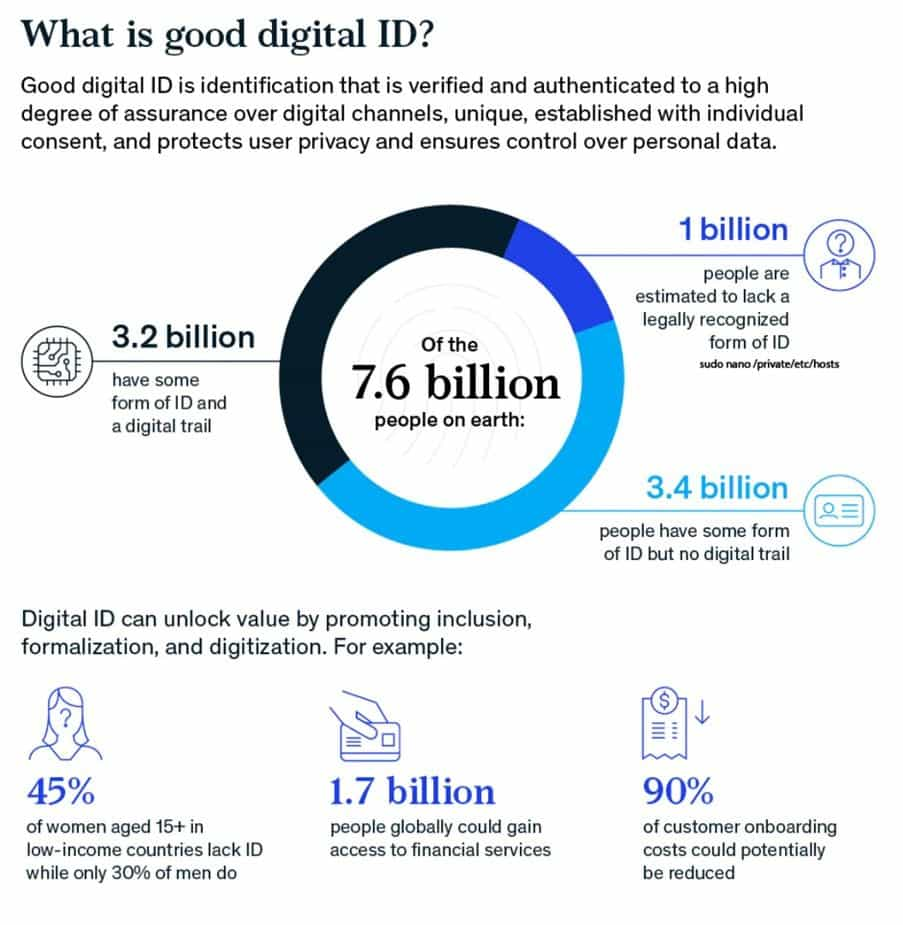
McKinsey – Opportunities of Digital IDs
The report believes “good” Digital IDs can unlock value for countries that may or may not function with a robust Digital ID system by fostering economic inclusion, protecting rights, improving security, and driving efficiency. Furthermore, it foresees the costs of operating digital ID falling with economies of scale. The report cites some successful Digital ID initiatives, including:
- India’s Aadhaar program which onboarded roughly 1.2 billion people since 2009.
- Banking consortiums of Norway and Sweden led programs to integrate into the country's financial and government services dubbed BankID.
- Estonian e-ID successfully transitions to e-government services.
The report lays down the key areas where Digital IDs could unlock value for individuals and institutions upon widespread adoption:
- For individuals, Digital IDs will improve financial services, employment, agricultural productivity, and efficiency.
- For institutions, Digital IDs can cut costs, reduce fraud, foster demand, improve labor productivity, and increase tax revenue.
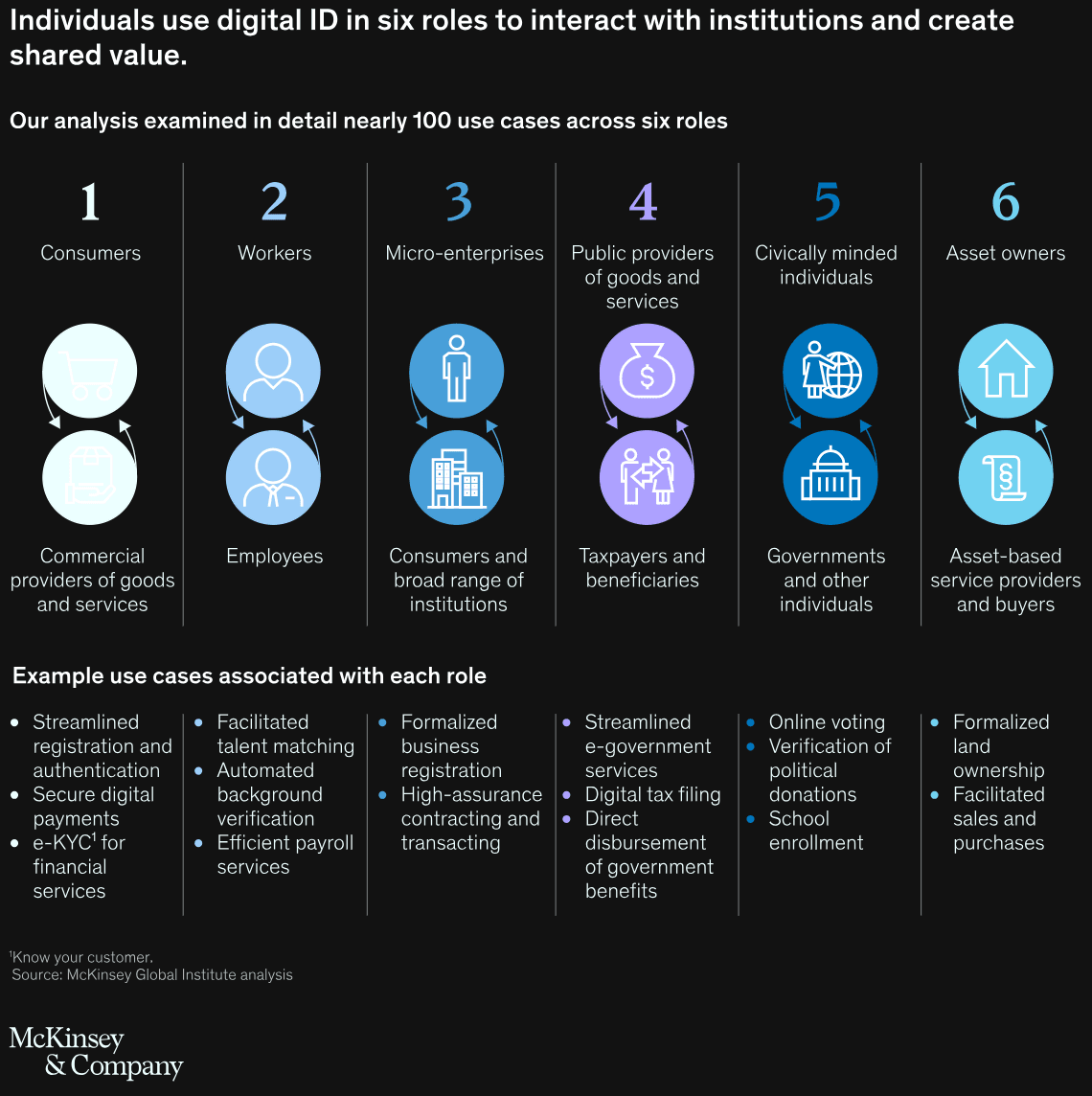
“Our analysis of Brazil, China, Ethiopia, India, Nigeria, the United Kingdom, and the United States indicates that individual countries could unlock economic value equivalent to between 3 and 13 percent of GDP in 2030 from the implementation of digital ID programs.” – McKinsey
Digital ID promises to enable economic value creation by fostering increased inclusion, which provides greater access to goods and services; by increasing formalization, which helps reduce fraud, protects rights, and increases transparency; and by promoting digitization, which drives efficiencies and ease of use.
Digital IDs Could Shape the Growth of Emerging Economies.
The report estimates the value Digital Identification technologies could unlock for countries. It comprehensively analyzes 23 economies, including Brazil, China, Ethiopia, India, Nigeria, the United Kingdom, and the United States. Based on country-level patterns, it deduced that by 2030, digital ID could potentially create economic value equivalent to:
- 6% of GDP in emerging economies and,
- 3% percent of GDP in mature economies.
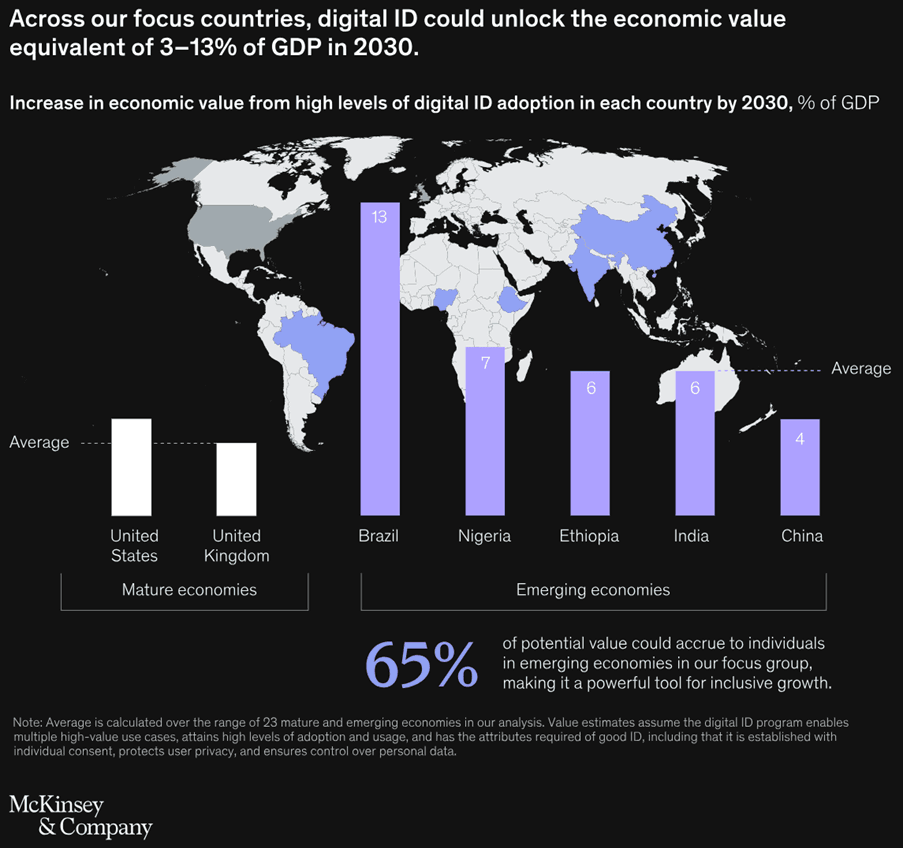
Growing Institutional Interest in Digital IDs
The McKinsey report claims that Digital IDs could source significant value for public and private sector institutions to improve their productivity and profitability. Several such global institutions have mapped out their interest in Digital IDs initiatives recently:
- The United Nations Development Programme’s (UNDP) Digital Strategy 2022-2025 aims to harness the power of digital technologies to accelerate sustainable development, reduce inequalities, and strengthen governance by fostering innovation, digital transformation, and partnerships.
- World Bank's ID4D (Identification for Development) initiative seeks to enable access to legal identity for all, including birth registration, by leveraging digital technologies and fostering collaboration among various stakeholders to improve development outcomes and empower individuals.
- The International Monetary Fund (IMF) recently discussed the importance of digital ID systems and digital public infrastructure for advancing economic and digital transformation ambitions during a seminar at the spring meetings of the Bretton Woods institutions.
- The Financial Action Task Force (FATF) has developed guidance to clarify how digital identity systems can be used for customer due diligence, aiming to help governments, financial institutions, and other regulated entities implement risk-based approaches to digital ID.
- The World Economic Forum (WEF) signed a strategic partnership with the UN to accelerate the 2030 agenda. Digital cooperation is one of the six focus areas of this partnership.
- The Bill and Melinda Gates Foundation supports the development and implementation of digital ID systems as a tool to expand financial inclusion, boost economic opportunities, improve access to social safety nets, and increase gender equality.
To understand the context of such unprecedented public and private sector interest in Digital IDs, let’s do a case study on the UN’s sustainability development projects of the early internet era – The Millenium Development Goals (MGDs).
Case Study – The Failure of MDGs
In 2000, the United Nations hosted the Millenium Summit in their New York HQ to discuss the role of the UN following the turn of the millennium. The summit saw the establishment of the Millenium Development Goals (MDGs), a set of eight international development goals to eradicate global issues such as poverty, hunger, gender inequality, and diseases. All 191 United Nations member states and several international organizations committed to achieving the MDGs by 2015.

As 2015 inched closer, it became clear that the UN had failed to meet all the goals set forth by the MGDs. The UN failed to achieve all the goals unilaterally across all participating nations. While some countries, like Brazil and China, achieved many goals by making monumental strides in curbing poverty, others were less successful. Issues such as gender inequality were persistent in many economies, and global dependence on climate-polluting and carbon-heavy resources could not be controlled.
Some Key Factors That Led to the Failure of MDGs:
- Unequal progress across the globe.
- Overambitious and unrealistic: Many critics argue that the MGD creation was overseen by globalist institutions that could not account for the local capacities and governance capabilities of the countries it targeted.
- Lack of synergy and interconnectivity: The MGDs did not consider the interconnectivity among goals, which hindered their efficient progress.
- Lack of accountability: The MGDs were made an international issue that demanded participation and initiative from all participating countries. However, the initial development of the MGDs was complete without consultation from developing countries, leading to a lack of interest and accountability.
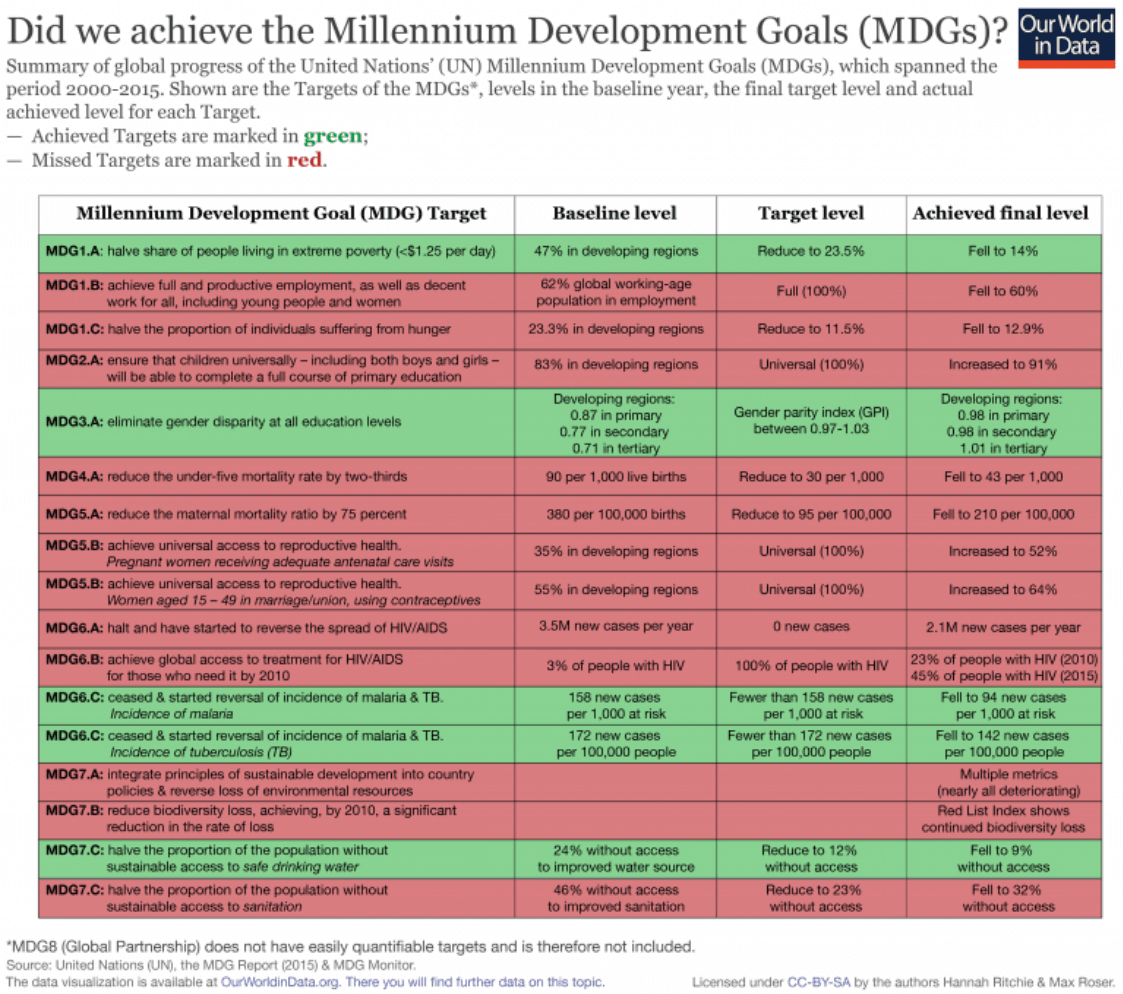
The Evolution of MDGs to SDGs
Foreseeing the failure of the MDGs, The United Nations Conference on Sustainable Development in Rio de Janeiro in 2012 marked the beginning of the Sustainability Development Goals as the successor to the MDGs.
The SDGs are intended to achieve the targets where the MDGs failed, including eliminating hunger and achieving full gender equality. The SDGs also urged the world to pave the path towards a greener planet and foster more inclusive societies to reduce economic inequality.
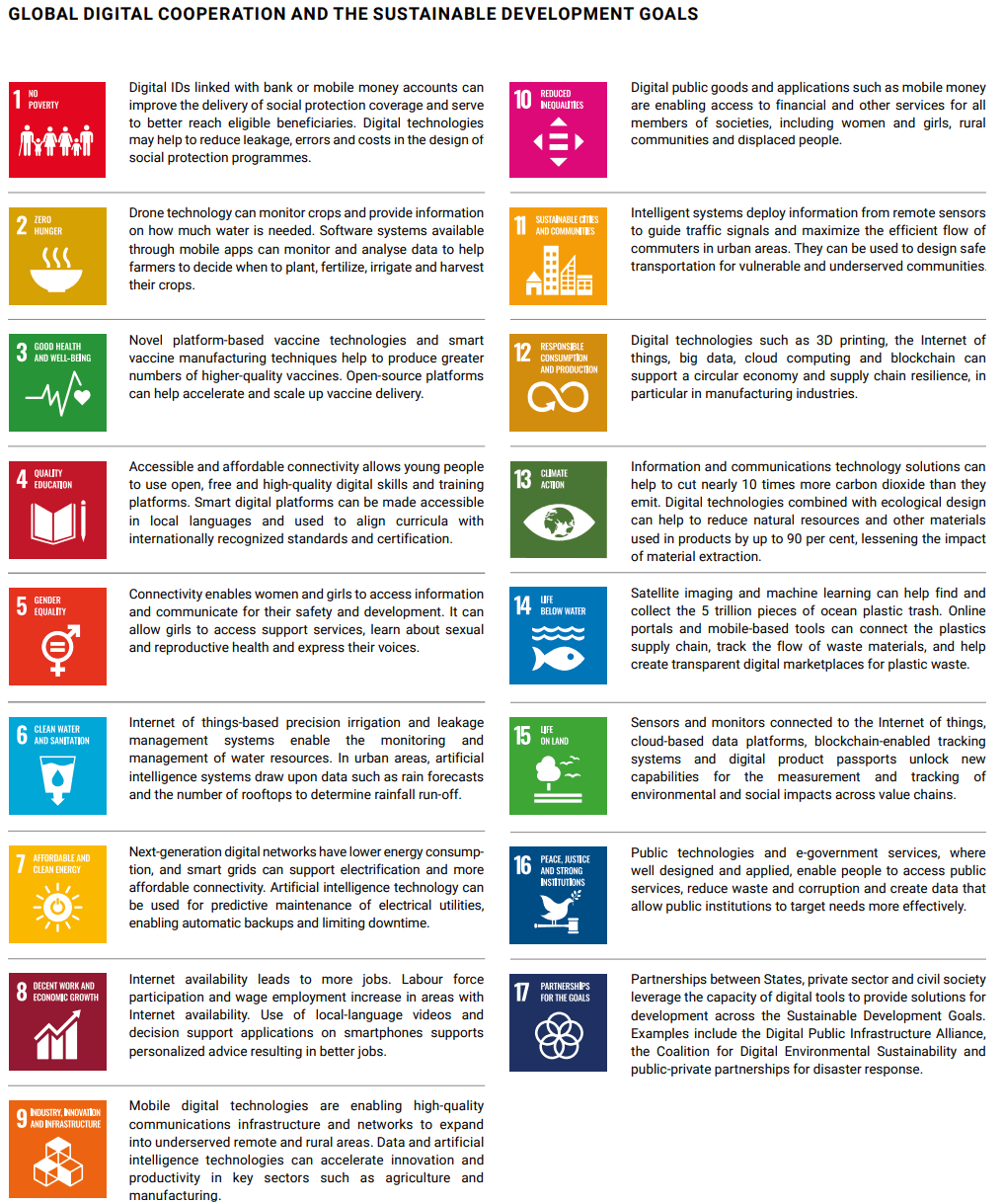
The United Nations adopted the 2030 Agenda of Sustainable Development, which included 17 SDGs, agreed upon by all 191 UN Member States. Everything from its design process to its implementation, the SDGs were designed to improve upon the shortcomings of its predecessor. Some key improvements over the MDGs include:
- Universal applicability: While the MDGs focussed on developing countries, the SDGs call for a global effort to establish cross-border collaborative strategies to amplify the synergies between economies.
- Comprehensive scope: The MDGs were spread across eight goals addressing broad issues. In contrast, the SGDs laid down 17 goals and 169 targets.
- Cross-sectoral and cross-institutional collaboration: The SDGs ardently emphasize such partnerships to accelerate the process of its goals. Primarily focusing on individual sectors, the MDGs did not advocate such cooperation.
- Extensive monitoring: The MDGs lacked appropriate monitoring, data-backed evaluation, and accountability. The SGDs pay greater importance to these factors to ensure an accountable and accurate track of progress.
- Partnerships: The SDGs dedicated a specific goal (Goal 17) to strengthen global partnerships to accelerate sustainable development. The MDGs lacked this proactive commitment to foster partnerships.
- Funding: The MDGs were designed to rely on aid flows from rich and developed countries to their target developing countries. In contrast, the SDGs call for a broader spectrum of fund sources, including public funding, domestic resources, private sector investment, and other revenue-generating capabilities the national economies can facilitate.
- Addressing climate change: The SDGs lays out more specific goals to combat climate change, promote sustainable cities, and responsible production and consumption. The MDGs did not target these subjects as explicitly as its successor.
Case Study Conclusion
A common theme is observable across all the improvements made to the SDGs – Fostering collaboration and synergy between individual sectors and public/private organizations. We have made generational improvements in cost-efficient global interconnectivity. Today, about 5.25 billion people have access to the Internet, accounting for about 66.2% of the population. Internet usage has increased by 1,355% since 2000. Therefore, we can conclude that harnessing modern wireless connectivity was essential to address the critical limitations of the MDGs. At the heart of this new potential for global collaboration are Digital IDs.
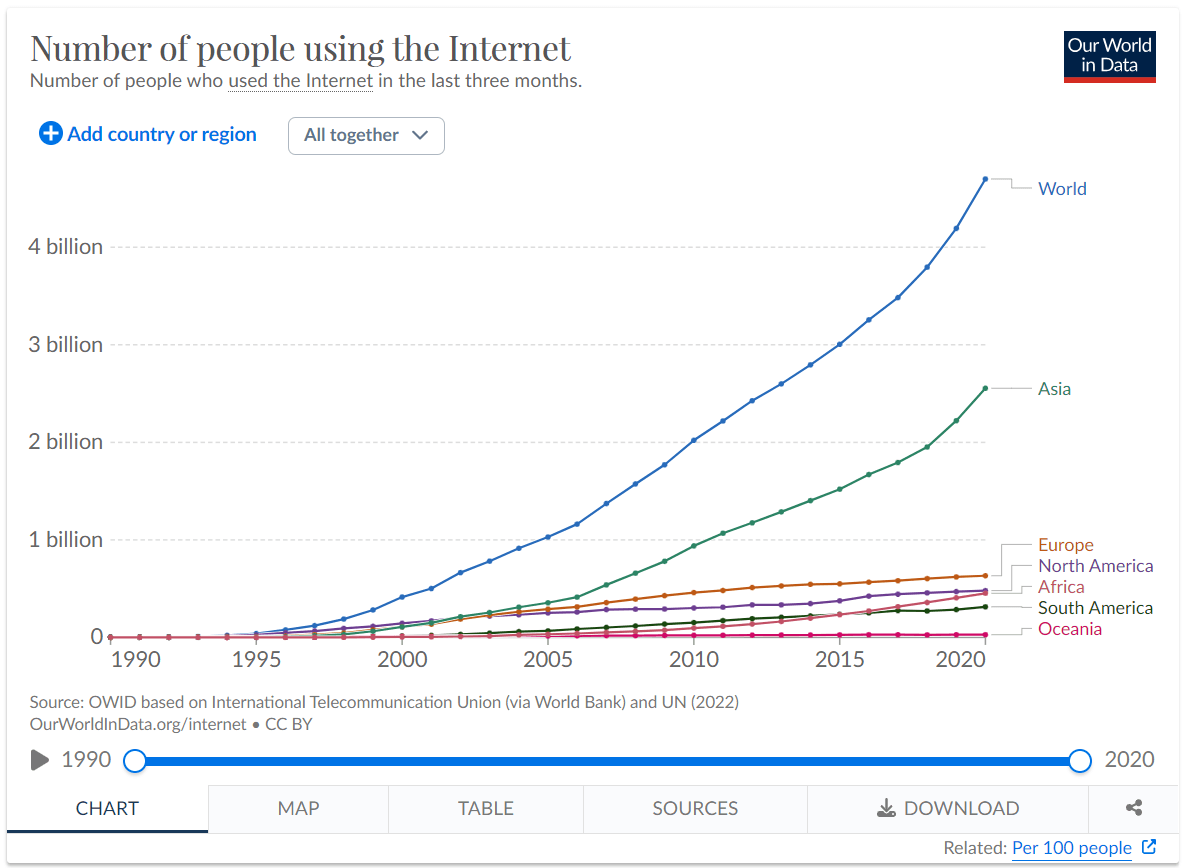
Role of Digital IDs in Advancing SDGs
Digital IDs play a pivotal role in advancing many of the Sustainability Development Goals set by the UN. It plays a direct role with specific objectives in some of the goals and an indirect role by facilitating the realization of other goals. These contributions are summarized as follows –
- SDG 1 – No Poverty: Digital ID can open access to financial services like social protection to its beneficiaries. They can tap into the previously unbanked population with reduced leakage, error, and costs.
- SDG 3 – Good Health and Wellbeing: During the pandemic, Digital IDs allowed contactless registration for vaccination and helped streamline its delivery.
- SDG 4 – Quality Education: Digital ID can help in easy registration, tracking student performance, and ensuring that resources such as scholarships or subsidies reach their intended beneficiaries.
- SDG 5 – Gender Equality: Robust connectivity with Digital identity enables easy access to information and support services. They can empower women by improving access to financial services as well.
- SDG 9 – Industry, Innovation, and Infrastructure: Implementing Digital ID promotes high-quality communications infrastructure. It also fosters innovation and efficiency with newer and faster digital systems.
- SGD 10 – Reducing Inequality: Digital IDs reduce inequality by opening access to services regardless of one’s gender, geography, or nationality.
- SGD 11 – Sustainable Cities and Communities: Digital IDs can help urbanize small cities and individuals. It can help calculate the need for various support services based on the surrounding demographics.
- SGD 17 – Partnerships for the Goals: Digital IDs can facilitate better data collection for monitoring progress towards the SDGs, promoting partnerships between public and private stakeholders based on concrete data.
The rising institutional interest in Digital IDs and its central role in the successful advancement of SDGs by 2030 presents a clear connection. Digital IDs are the vessel for global institutions like the ones mentioned above to participate in achieving Sustainability Development Goals.
This conclusion agrees with several key areas of improvement the SDGs sought out over its predecessor. The SDGs advocate extensive data-backed monitoring and partnership with private and public stakeholders alike. The SDGs also broadened the scope of its funding to include private sector investment from domestic and international sources. Digital ID lays the groundwork to render these improvements to the SGDs.
The Role of Institutions in Advancing the SDGs
The United Nations Development Programme (UNDP) is a global organization that operates as the UN’s primary development agency. UNDP works with over 170 countries to provide assistance and guidance to foster inclusive growth and achieve the UN’s Sustainability Development Goals.
The UNDP Digital Strategy 2022-2025
It lays down the UNDP Digital Strategy 2022-2025, a forward-looking framework to harness the potential of Digital IDs and accelerate the progress toward SDGs. The Digital Strategy is designed to support countries' inclusive digital societies aligned with the UNDP’s guiding principles:
- To put human rights at the center.
- Promote inclusive and gender-sensitive approaches.
- To implement global standards and frameworks that protect people’s rights.
- To advocate open digital standards and open data.
- To strengthen local digital ecosystems.
- Leverage strategic partnerships to catalyze inclusive approaches to digital development.
UNDP's Whole-of-Society Approach
UNDP seeks to establish partnerships to empower its proposed digital ecosystem. It will deploy a whole-of-society approach, where UNDP will support its partners in designing public digital policy. The approach will engage governments, local businesses, and civil society to develop regional digital policies to establish accountability.
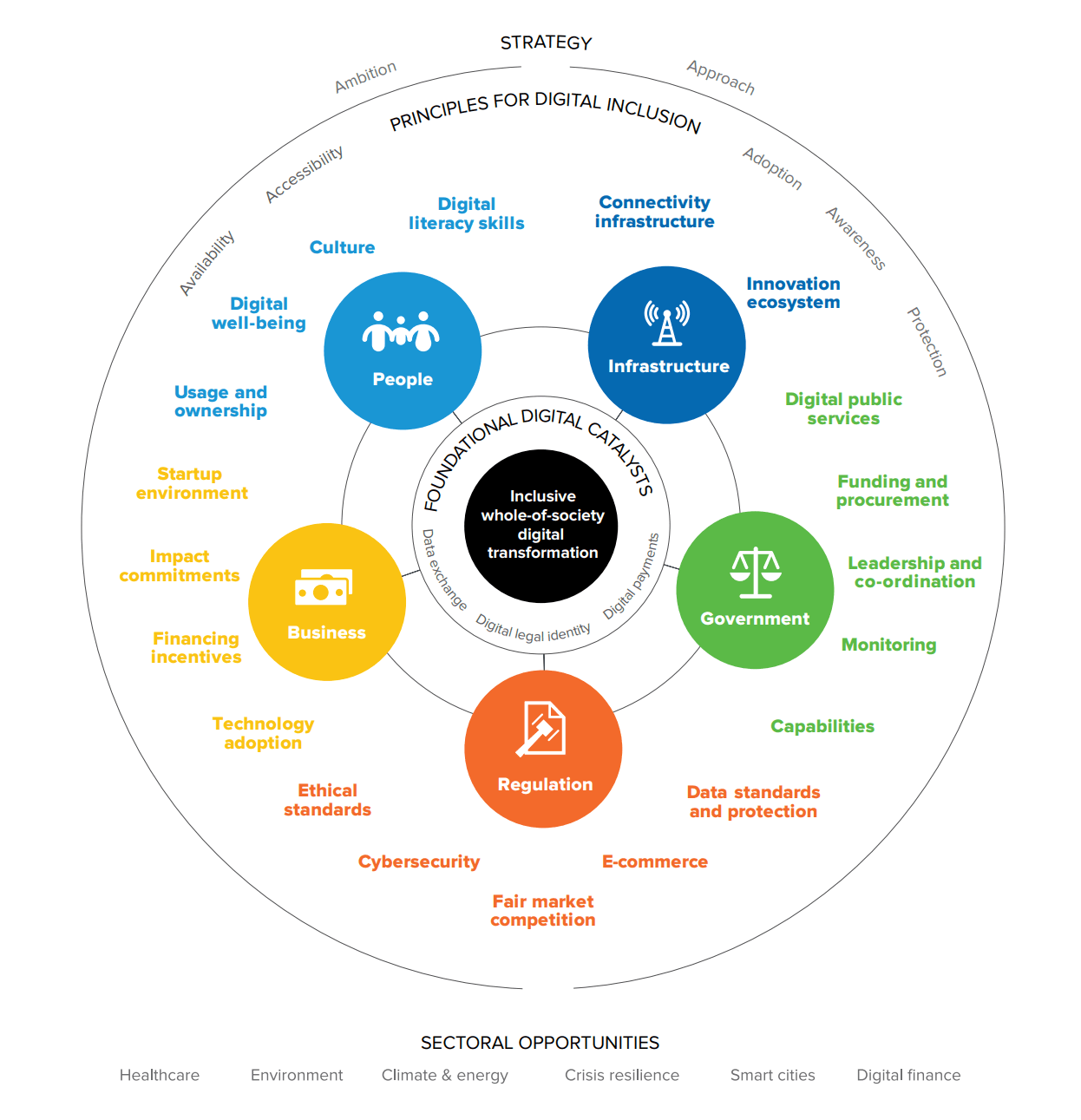
UNDP Digital Strategy Implementation
A Chief Digital Officer will be the executive head accountable for implementing UNDP’s Digital Strategy. This post will be supported by advisory bodies at the executive and regional levels to provide guidance over general strategic implementations and specific country-facing initiatives.
The Chief Digital Officer and its supporting bodies will oversee the implementation of the Digital Strategy. However, the UNDP will set up various ground-level bodies to carry out the operational objectives set out by the Officer. Some of these bodies are described as follows:
- Country offices – The primary drivers of digital program design and implementation in the field.
- Accelerator Labs – Support innovation of digital solutions based on local context and through country-led experimentation.
- Regional bureaux – They will identify regional programmatic opportunities and lead regional digital partnerships. They will provide the necessary support to help identify opportunities for strategic deployment of Digital initiatives.
- Global headquarters – They will provide corporate guidance and create policies, guidance, and tools to support digital transformation. Headquarters units will also support knowledge management efforts for digital approaches across various areas.
- Global policy centers – They will provide an opportunity to extend UNDP's capacity in specific policy/thought leadership areas.
The UNDP intends for the central and regional bureaux and the country offices to take on the primary role of driving and supporting the execution of the Digital Strategy. Chief Digital Offices will focus on strategic positioning, capabilities building, digital innovation, and scaling support. These offices will take on the thought leadership role in specific areas as necessary. - UNDP Digital Strategy Report
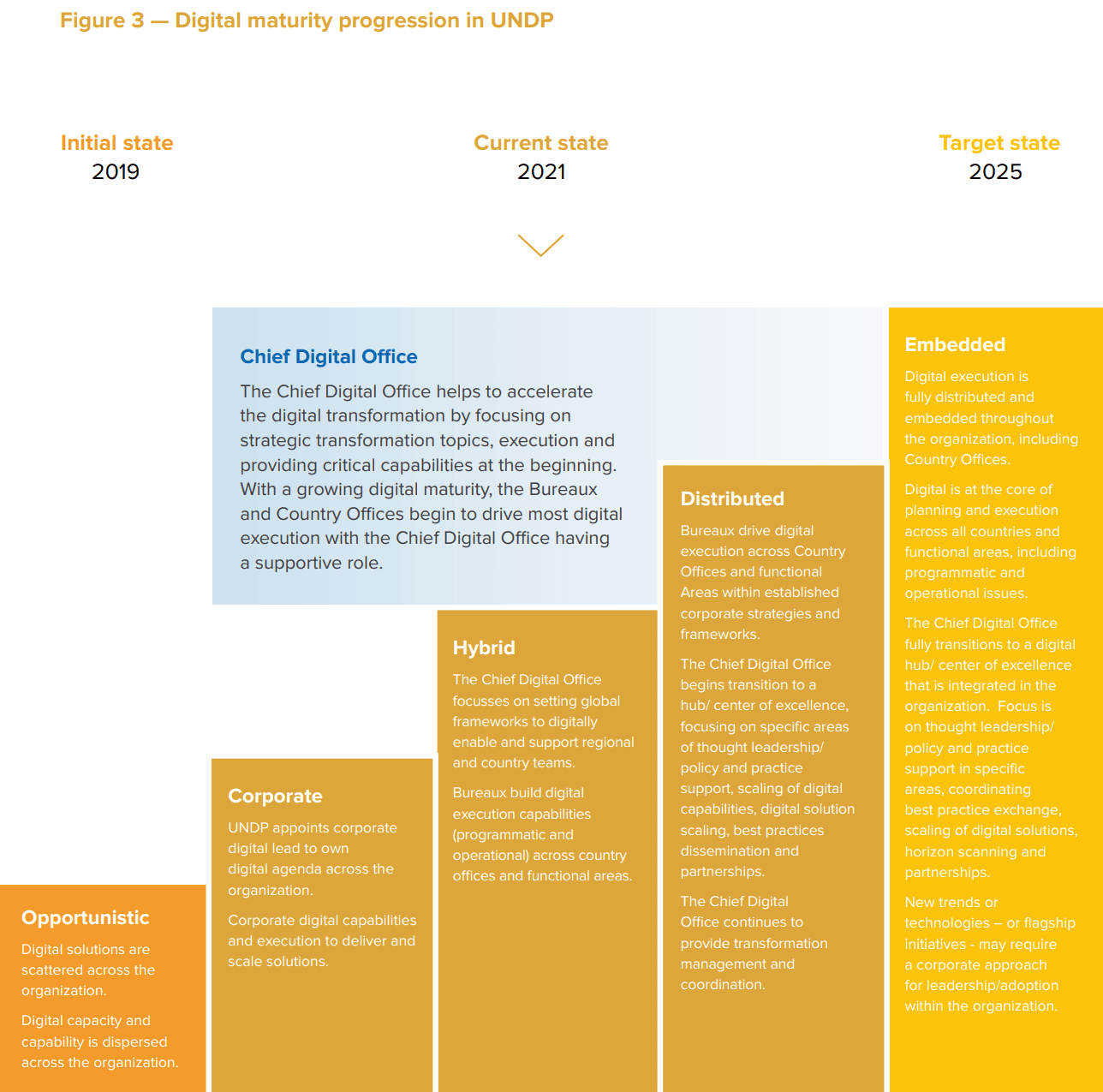
Will the UNDP's Digital Strategy Succeed?
The UNDP report acknowledges that Digital Identification technology is constantly evolving, along with the global geopolitical landscape. The trajectory of digital technologies could evolve multiple divergent paths with time.
In light of this belief, the report lists four possible scenarios its Digital initiative could transpire into. These scenarios are laid out in a spectrum that features major issues such as the extent of commitment to sustainability, the impact of rapid automation, the increasing digital divide, and the capacity of national governments. The scenarios are summarized as follows –
Scenario 1 - “On The Same Trajectory”
This future considers the exponentiation of all the issues and problems we already have in the present, but increased in scale with time; key insights include:
- A few privileged groups receive the benefits of advancing technology, which increases the economic divide between communities.
- Big tech and private institutions have more power over people than nation-states. Their influence is magnified by automation and data monopolization.
- Climate disasters accelerate, and rich states have the largest contribution to the global carbon footprint.
The probability of this dystopian future is among the most prominent cases critics of the UN’s sustainability initiatives have made. The public sector is motivated by its need for surveillance and control, while the private sector is motivated by profits. This scenario argues that the UNDP will fail to establish ethical and sustainable relationships with its strategic public and private partners, who will fund the SGDs as a means to mobilize their personal agenda.
As Digital ID will centralize all financial, social, and governance architectures around the globe, its public and private facilitators will gain access to unprecedented data. Emerging economies and small businesses will only survive with cooperation with Big Tech and other developed economies.
Scenario 2 - “Falling into the Abyss”
This future witnesses the failure of most systems, including Sustainability initiatives. Some key insights are:
- With the sudden failure of our major systems, the world becomes economically unstable with lots of frustration, fear, and social anxiety.
- Rapid automation kills several employment avenues, leaving many people without a means to live.
- Rampant population growth and unchecked use of natural resources deplete global deposits.
This scenario witnesses the fall of centralized governing bodies around the globe, compelling communities to self-organize and de-globalize. Interestingly, as this future depicts a complete failure of centralized decision-making, it could be a future where decentralization and Web3 proliferate.
With complete distrust in trusted governance systems, economies could opt for blockchain-based trustless governance models. This future describes the perfect set of conditions that will lead to adopting non-custodial and decentralized Proof of Identity systems.
Scenario 3 - “Radical New Norm”
Arguably the most pessimistic projection of all, it is built upon the same principles of complete failure of trust and institutions as the 2nd scenario. Here are some key insights:
- Large societies and nation-states are disbanded into small groups with limited connectivity and exchange of resources and information.
- Travel has slowed completely, food is local and seasonal, and local business and community renaissance has become the norm.
- Work has transformed dramatically. There are very few paid jobs, and most communities run on the voluntary effort of their community members.
While the power is with both the corporations and the people, a future like this could potentially see the emergence of hybrid Digital ID systems. For instance, the state could foster general-purpose identification while private bodies carry out function-specific identification.
Scenario 4 - “In Pursuit of Sustainability”
This is the ideal outcome the SDGs are in pursuit of, a future of equal opportunities and sustainability; some key characteristics that define it are –
- Humans learn to limit the use of vital resources so that future generations can meet their needs.
- Funds are shared between governments and citizens. Social and financial services are universally available and accessible.
- Humans learn to harness AI to open new synergetic opportunities, producing more growth and making education, health care, and transportation more accessible.
A sustainable future like this one has learned to deploy revolutionary technologies like AI and digital IDs ethically, transparently, and responsibly. Humanity is heading towards greater prosperity.
Can Web3 Accelerate the “Pursuit of Sustainability”?
Let’s circle back to our initial analogy from the introduction. Fearing the use of the panopticon as a tool for oppression, Bentham developed the anti-panopticon later in life. An anti-panoptic design is one where the guardian sits in an exposed room and is surrounded by the members of the public. The idea was to keep power in check with transparency by enabling symmetric surveillance between the public and the center of power.
The Digital Identification systems used in blockchain-based decentralized settings are particularly anti-panoptic. This is because the protocol that issues a digital identity cannot control the digital credentials, which live transparently on a public ledger.
Case Study: Worldcoin - The Most Ambitious Web3-based Digital Identity Project
The Worldcoin Protocol is an ambitious Proof of Personhood project by Open AI CEO Sam Altman. The Worldcoin Protocol claimed to have answered the global need for a non-custodial and privacy-preserving identity. The project used fancy eye-scanning devices called Orbs to tokenize a person’s iris-based biometric identity to issue them a Digital ID on the blockchain. The protocol also attempted to issue UBI with its native WLD token to its verified users. Despite being the most sophisticated blockchain-based Digital Identity project, Worldcoin raised some serious concerns:
- Its iris-scanning technology was plagued with privacy loopholes.
- The manufacture of Orbs and the storage of their credentials was opaque and centralized.
- The project faced several security risks, including selling IDs and government coercion right from the beginning of its operations.
- The WLD tokenomics were not robust enough to support UBI or store of value.
The case of Worldcoin proved the difficulty of rendering public services like Digital identification with Web3 native primitives.
Case Study Conclusion
Whether it is an organization like the United Nations that projects itself as a body working towards the betterment of humankind or a pseudo-Web3 digital identity project like Worldcoin, the analysis above illustrates that if there is any room to act in self-interest, it is our second nature to act on it.
This is precisely where Web3 native Proof of Personhood projects shine. An on-chain identity is permissionless, self-custodied, and transparent, which means its authenticity is openly verifiable and its usage is traceable, which ensures it is used ethically. Here is a list of some more promising blockchain-based Digital ID projects:
- Vitalik Buterin originally conceived Soulbound tokens. A Soulbound token is an NFT linked to a private key. Unlike conventional NFTs, they are designed to be non-transferable and un-financialized (they do not accrue value). Many projects like Otterspace, Masa Finance, and Noox have built on Vitalik’s idea.
- Proof of Humanity is an identity project that leverages a person’s social network to issue an on-chain identity. Previously verified individuals vouch for new participants to prove their uniqueness, which can, in turn, vouch for others once verified. This may help combat things like spam bots and scam profiles.
- BrightID is a digital identity project where participants join an online verification party and verify one another.
- There have also been attempts to use CAPTCHA tests to verify humanness and issue digital identities on the blockchain. Idena is one such attempt.
Some risks specific to blockchain-based digital identity systems hinder it from challenging international efforts like the United Nations Digital Strategy that are worth exploring.
- Adoption - The learning curve of registering and using blockchain-native digital identity systems is still quite steep. Adequate education and familiarization with blockchain technology are essential for its global adoption.
- Scalability - Despite access to high throughput ecosystems like Ethereum layer-2s, the cost of writing data on the blockchain is too high to serve a need as fundamental as identity.
- Regulation - The regulatory landscape surrounding blockchain technology is still evolving. As the authorities begin to understand the potential of blockchain technology, more informed regulations are probable.
- Identity fragmentation - Numerous identity issuance protocols are currently under development in Web3. A uniform global digital ID standard is essential to ensure interoperability across various geographical and functional settings.
Any new technology that has the potential to redefine the most fundamental attributes of how humans interact as a society may face similar risks initially. They are addressable with time, research, and support from local authorities. However, using a hybrid of blockchain technology with public sector undertakings to issue digital identification has shown some promise; here are a few instances –
- Thailand: Thailand has made good progress with its blockchain-based biometric digital identity infrastructure, which had enrolled over 9 million people by November 2022.
- South Korea: The South Korean government has plans to use blockchain to secure the digital IDs it issues to its citizens using smartphones.
- Estonia: Estonia has digitized its public services with its e-Estonia initiative, powered by the KSI blockchain technology.
- United Arab Emirates: The UAE government launched the Emirates Blockchain Strategy 2021 with the goal of conducting government transactions on the blockchain.
- Singapore: The Monetary Authority of Singapore is exploring the use of blockchain for the clearing and settlement of payments and securities through its initiative, Project Ubin.
Closing Thoughts
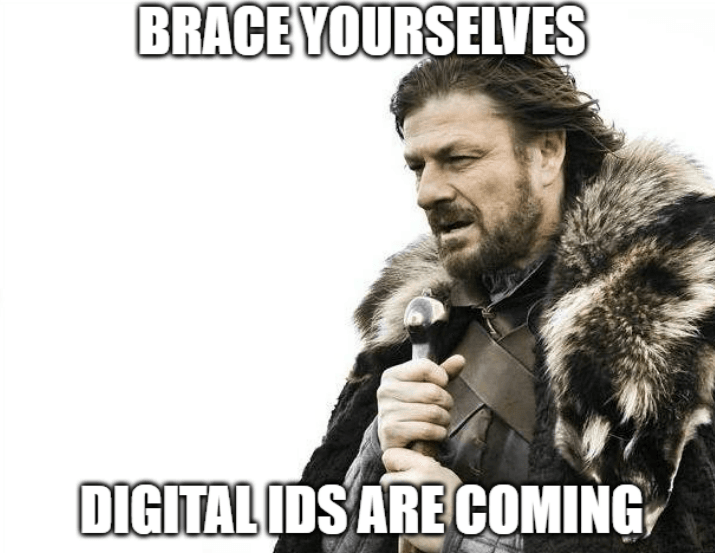
The United Nations makes a very clear and robust case for the potential for Digital IDs in achieving its SDGs. Interestingly, the UNDP’s Digital Strategy 2022-2025 makes several assumptions to sell the idea of making Digital IDs an integral part of the world economy. These assumptions raise some dystopian risks that are worth exploring –
Digital Divide
McKinsey Global Institute’s report on digital identification estimates that basic Digital ID alone could unlock over 50% of the total economic potential in emerging economies. However, the report makes a lofty assumption of the adoption rate reaching 70% to hit this goal. If Digital IDs need to penetrate this deep into the economy to unlock value, there is a risk of unintentionally exacerbating the digital divide between technologically rich and backward nations.
Cybersecurity
Digital IDs are all-encompassing cross-functional identification tools. Their extensive scope exponentiates the risk of cyberattacks. Their wide use cases make Digital IDs spots of concentrated value, which incentivizes attacks and data breach attempts.
Privacy and Surveillance
The UNDP supports partners in developing policies that protect governments and citizens from data privacy risks. This means that while the UNDP will aid its stakeholders in adhering to appropriate privacy-protecting practices, they are largely left to fend for their own specific privacy initiatives. This significantly raises concerns about increased surveillance without consent, undermining human and civil rights.
Disinformation
Digital IDs are a novel concept that is susceptible to incorrect interpretations, increasing the potential for disinformation. A lack of coherent knowledge across target economies and demographics can fuel unrest and undermine trust in the UN.
Frequently Asked Questions
Digital IDs are a collection of electronically captured and stored attributes and credentials that uniquely describe a person within a digital system or network environment. They include personal information such as name, date of birth, social security number, and other data that can be used to identify an individual online. Digital IDs play a crucial role in verifying identity, enabling secure access to online services, and facilitating transactions in the digital world.
Digital IDs offer several benefits, including:
- Enhanced access to services: They unlock access to various online services, such as banking, healthcare, and government programs, making it easier for individuals to participate in the digital economy.
- Improved security and privacy: Digital IDs provide a secure way to authenticate users, reducing the risk of fraud and identity theft while allowing individuals to control their personal information.
- Streamlined processes: They enable faster and more efficient transactions, minimizing the need for physical documents and manual verification.
- Cost-effectiveness: Digital IDs reduce the cost of administering public services, as digital processes minimize the need for physical documents and manual verification processes.
- Inclusivity: They can help promote social, civic, and political inclusion by providing a means for individuals to access essential services and exercise their rights
The risks associated with digital IDs include:
- Cybersecurity breaches: Digital IDs can be vulnerable to hacking, potentially exposing sensitive personal information and compromising the security of online transactions.
- Privacy concerns: The collection and storage of personal data can lead to privacy violations and increased surveillance.
- Human execution errors: Mistakes in implementing or managing digital ID systems can result in unauthorized access or exclusion of individuals.
- Exclusion: Some people may be left out of digital ID systems due to a lack of access to technology or other barriers, exacerbating inequalities.
- Misuse of data: The ease and speed of digital data transfer can lead to unauthorized use or manipulation of personal information.
- Authoritarian control: If governments choose to abuse this power, they will be able to exercise near total control over individuals in a population.
The UNDP Digital Strategy 2022-2025 is a framework that aims to harness digital technology and innovation to address development challenges effectively. It focuses on transforming UNDP's operations and programmatic offerings, supporting governments and partners in their digital journeys, and fostering an inclusive, ethical, and sustainable digital ecosystem.
Disclaimer: These are the writer’s opinions and should not be considered investment advice. Readers should do their own research.


